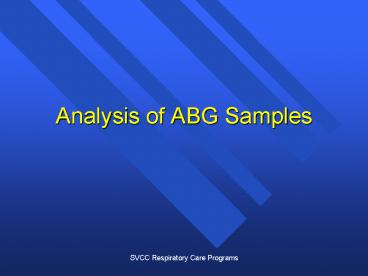Analysis of ABG Samples - PowerPoint PPT Presentation
1 / 18
Title:
Analysis of ABG Samples
Description:
... is done by setting the 'slope' potentiometer to a low pH buffer (6.84) and ... the 'balance' potentiometer with a near-normal buffer (7.384) with an ... – PowerPoint PPT presentation
Number of Views:642
Avg rating:3.0/5.0
Title: Analysis of ABG Samples
1
Analysis of ABG Samples
2
ABG Analysis, Introduction
- pH, PaCO2, PaO2 are measured directly by special
electrodes contained in a device made for that
purpose - Other indirect measurements can be made or
calculated from the above measurements i.e.,
HCO3-, O2 Sat.
3
pH
- pH electrode is constructed of two half cells,
which develop an electrical potential when
connected together - Reference electrode maintains a constant
potential and is bathed in KCl - Glass electrode (Sanz electrode) develops an
electrical potential that is proportional to the
amount of H present
4
PaCO2 Electrode (Severinghaus)
- Measures carbon dioxide tensions by allowing the
CO2 gas to undergo a chemical reaction that
produces hydrogen ions - The hydrogen ion concentration produced is
directly proportional to the PCO2 in contact with
the membrane of the electrode - Operates on the principle of electric potential
between electrodes - CO2 H2O H2CO3 H HCO3-
5
O2 Electrode (Clark)
- Is a polarographic device that measures oxygen
tensions by oxidation/reduction reactions, a
chemical process that generates measurable
electrical currents - Has platinum cathode and silver anode immersed in
an electrolyte solution - Volume of O2 will be directly proportional to the
number of electrons used in the cathode rxn. and
by measuring current ? is a measure of O2
diffused across membrane
6
QA in Blood Gas Analysis
- ABG lab must be able to assure accurate and
reliable results - The above is accomplished by applying protocols
in 3 areas - pre-analytic error -
calibration - quality control
7
Pre-analytic Error
- All factors that cause variance in lab results
prior to the sample arriving in the ABG lab. - 4 factors assoc. with signif. P. E. are - air
bubbles in sample - - time delay (iced sample with more than 60
min. or uniced with more than 10 min.) - - blood clots in sample
- - small sample size where excessive
anticaogulation is suspect
8
Calibration
- Purpose is assure consistency
- Def. the systemic standardization of the
graduation of a quantitative measuring instrument - Calibrating standards for blood gas analyzers
should simulate the physical properties of blood
and meet manuf. specs. - When 2 standards are used ---gt 2-point
calibration, performed after 50 blood gases or at
least every 8 hours
9
Calibration (contd)
- A one-point calibration is an adjustment of the
electronic response of an electrode to a single
standard and is performed more freq. than a 2 pt.
cal., ideally prior to each sample analysis
10
pH Calibration
- Several types of buffer solutions are acceptable
for pH electrode calibration - Buffers are excellent standards because of their
long shelf life and stability for days after
being opened - 2-point cal. of pH electrode is done by setting
the slope potentiometer to a low pH buffer
(6.84) and setting the balance potentiometer
with a near-normal buffer (7.384) with an
accuracy of /- 0.005
11
PaCO2 Calibration
- PaCO2 electrode may be calibrated by introducing
a known gas concentration - Gases used are 5 and 10 CO2, /- .03 - 1-point
cal. uses 5 standard to set the balance
point - 2-point cal. uses 5 for balance
point and 10 for slope point - PCO2 (BP - 47 mmHg) x CO2
12
PO2 Calibration
- Properly calibrated PO2 electrodes perform within
the manuf. stated accuracy in PaO2 ranges below
150 mmHg but may vary 20 at 500 mmHg - 0 oxygen is used for the slope point and 12
or 20 for the balance point - PO2 (BP - 47 mmHg) x O2
13
Quality Control
- Refers to a system that documents the accuracy
and reliability of the blood gas measurements and
is essential to assure accuracy in the blood gas
lab - Media available as blood gas controls include
- - aqueous buffers
- - glycerin soltn.
- - human/animal serum and blood - artificial
blood - A QC system must ID problems and specify
corrective action, document. of accept. oper.
14
QC (contd)
- Documentation of QC is usu. on Levy-Jennings
Chart which shows measured results on the y axis
versus time of measurement on the x axis - SD is used to summarize a mass of data the
difference between a number in a data set and the
mean of the data set is called a deviation. A
deviation shows how much a number varies from the
mean
15
QC (contd)
- A properly functioning electrode that repeatedly
analyzes a known value will produce results
within a rel. small range, e.g., a PaCO2
electrode that analyzes a 40 mmHg standard 100
times will produce results where 2/3 of the
measurements are 39 - 41 mmHg and nearly all
measurements fall in 38 - 42 range - 95 of the control measurements should fall
within 2 SD
16
QC (contd)
- Random errors indicates a value outside of 2 SD
of the mean a single random error has minor
signif., but if number increased the machine and
techniques must be evaluated - Systematic errors is recurrent measurable
deviation from the mean - Causes of systematic errors
- - contaminated standard
- - variations in electrode temp.
- - inconsistent introduction of standard
17
QC (contd)
- Causes of systematic error (contd) -
inconsistent calibration technique - change in
QC standard storage or prep. - electrode
problems, e.g., protein contamin., membrane
malfunction, contamin. electrolyte, or
electrical problems
18
QC Levels
- Level 1 simulates a patient hypoventilating
- Level 2 simulates a patient with normal
ventilatory status - Level 3 simulates a patient hyperventilating































